Review Nokia 7210

Nokia 7210, live pictures
The 7210 is the first attempt of Nokia to create a phone with a colour screen.
Only Samsung and SonyEricsson have presented such handsets before. Nowadays a
leader of the market decided to win consumers sympathy. Nokia 7210 continues a
current line, it is an innovative model and its series number proves it. Traditionally
the 7-th series is innovative models. In reality there are not so many new features
here, but still they are. Let's turn to the phones capabilities and describe them
more closely.

The phone is available in three colours: Turquoise, Orange and Brown.
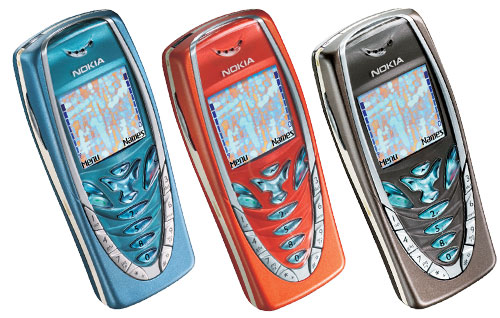
You can change a design of the phone with a help of the interchangeable Xpress-on
TM covers ( Black, Red, Pink, Green Grey, Maroon and Yellow). To change a cover
you should firstly remove the rear cover and then the front one. There is a holder
behind the phone which you should to push and then remove the cover by the second
hand. The only problem that it's rather hard to do it as in the first lots of
Nokia 3310, the cover fits the handset tightly.

The phone's dimensions (106 x45 x17.5 mm) are not very large, it can be easily
held in the breast pocket or in the pocket of trousers. The handset weighs 83g.,
that is not much. One of the factors, which influences the weight reducing, is
a new battery - BLD-3. It is a lithium ion battery of 720 mAh capacity. According
to the manufacturer it provides 220 hours of the autonomy in the standby mode
and 4 hours in the talk mode. In practice the phone worked about 4 days in case
of 45-60 minutes of talking (Beeline Network). Additional phones applications
were almost not used. If to work with organizer, games and alarm clock (about
50 minutes) the phone's autonomy will reach only 3 days. It's not bad, especially
if to take into account an availability of colour display. The time of full recharging
is approximately 1.5 hours.
The screen shows up to 4096 colours and has a resolution of 128x128 pixels.
Usually in the vast majority of menus up to 5 text lines and 1 service line are
displayed. When you input short messages 2 service lines and up to 8 text lines
can be displayed because of scaling. Color rendering of the screen is quite good,
the information is not so bright in sunny weather outside but it's visible. There
are no problems at all in candlelight. The display is comparable in quality to
the one of Nokia 7650, only the size differs.


You can see a plastic keypad under the screen. The form and the spacing of
the keys are very unusual. These designer innovative ideas changed the phone's
appearance greatly. Unfortunately not always a style means comfort. Here is the
case. Lower keys are too closely spaced, on the contrary, upper keys are far from
each other. Of course, you get used to such keypad but you need time to do it.
As for me the keypad wasn't handy but all people have different tastes and may
be somebody will be satisfied with it. The backlighting of the keys is not equal,
keys 1,3 and 4 are not clear visible even in the average light conditions.
There is a double volume key on the left-hand side of the phone. It is rather
hard to press, probably, it was done to avoid accidental pressing.

A power key and IR port are placed on the upper side of the phone. A system
connector - Pop-port - is positioned on the bottom. It's firstly applied namely
in the 7210 and it will be used in the next models too. What are its advantages?
Firstly, Pop-port can automatically identified all attached accessories. Secondly,
a support of stereo sound is included in the connector, what allows to use stereo
headphone (they are in the standard kit of the 7210). Thirdly, a system connector
enables to energize all external accessories and there is no need to provide separate
power sources. Finally, Pop-port supports a high data transmission rate (up to
230 Kb/sec). The 7210 is supplied with a USB cable as an additional accessory.
So a new system connector has many advantages, but of course the owners of the
accessories to the old models will have to renew them.
Menu
A menu structure of the 7210 doesn't change as to compare it with other phones
from Nokia. But icons of the main menu are different now. Also a number of items
in the main menu increased to 13. The menu can be accessed by using shortcut numbers
or by scrolling. The first way is more convenient because scrolling needs much
time now.
Phonebook. The phonebook offers the similar possibilities as Nokia 6310,
8910 and others. You can add up to 3 numbers and 1 text field to each contact.
The dynamical memory enables to save up to 5 phone numbers and 4 text fields for
each block if you have less than 300 contacts. There are also caller groups here.
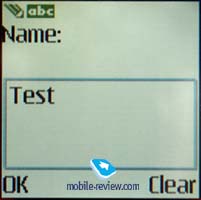 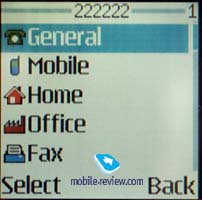
You can view the SIM card memory and the phone memory at the same time. You
can copy your phone numbers from the SIM card to the phone and vice versa.
Messages. The phone supports concatenated messages (up to 459 characters)
and Nokia Smart Messaging. There are 10 pre-default small graphic pictures to
decorate a message and templates to speed up text input. You can also use a predictive
text input while creating messages. A Chat feature is available.
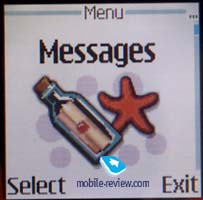 
The phone allows to send and receive MMS messages. Graphic images and sounds
are added to the phone memory for this purpose. You can also download some more
from Nokia site (the service is not available yet). It's the second phone (not
smartphone) after SonyEricsson which supports this feature.
Up to 150 short messages and 50 graphic messages can be stored in the phone
memory. Remaining free space is used to keep MMS messages, Java programs, sounds,
ringing tones and graphics. The phone memory is 500 Kb by default.
Call lists. Lists of received, dialed and missed calls with a possibility
to view date and time. Each list contains up to last 10 phone numbers. There are
also cost and duration counters here.
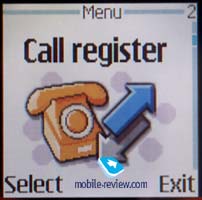
Profiles. Nothing extraordinary. Usual possibilities to personalize
your phone. All the settings can be activated till the specific time.

Settings. What's new? I can notify settings for the screensaver (like
analog clock) and for wallpapers (one of the graphic files). Also a user can set
a colour scheme of the menu (one of the 11).
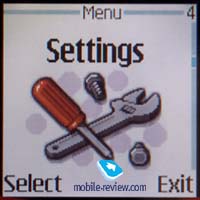 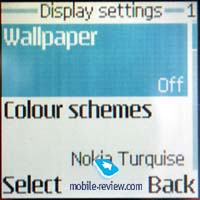
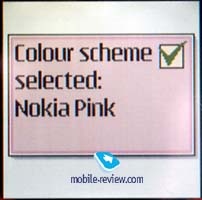 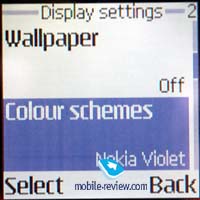
There is an automatic keypad lock in the 7210.
You can also adjust vibrating alert and a ring here, though it's more logical
to do it from the menu “Profiles”. Usual phone settings are also placed
here.
Alarm clock. It is rather simple and can be set only for a certain time.
Radio. There is a stereo FM radio here (stereo is because of the Pop-port).
Stereo headphones are available in the standard kit. The radio is similar to the
one in Nokia 8310 or 6510 by its capabilities.
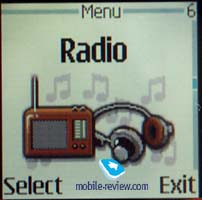
Gallery. All graphic and sound files are kept in this menu. There are
also settings for the access to download new files (wap). One can create own folders
here.
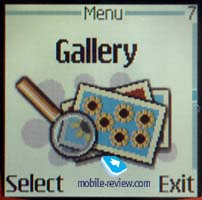 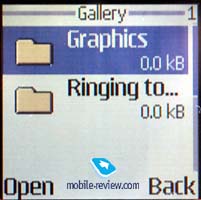
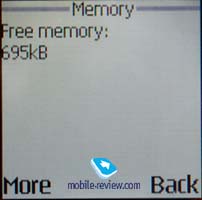
Organizer. This feature is realized as in the other phone from Nokia,
for example in the 6510. You can add from 100 up to 500 notes, it depends on their
length. An automatic deletion of the old notes is available (on the basis of time).
The calendar has a monthly view and you can quickly find a desired date.
 
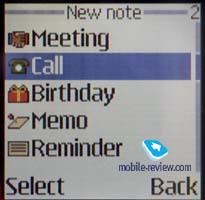 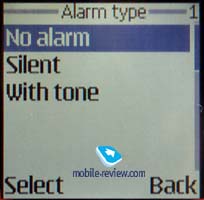
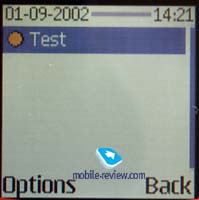 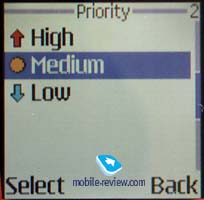
You can set a deadline for event in the to-do list.
Games. The games are the same as in Nokia 9210. So, two pre-default
games Tripple Pop and Bounce (Java applications) are placed here.
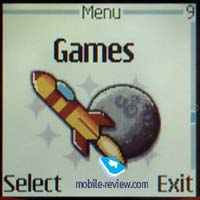
Applications. Installed Java applications are kept in this menu. There
are two of them in the standard kit: Dictionary and Converter. Unfortunately,
my sample didn't contain the first one and that's why I can't estimate it. Converter
enables to convert centimeters into foots, kilograms into pounds and so on. We've
already seen such application in the other models.
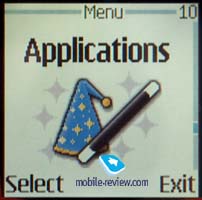
Extra. Everything is standard: calculator, countdown timer and a stopwatch
(split, lap time and a possibility to save results).
 
Connectivity. GPRS settings and switching on of the IrDa.
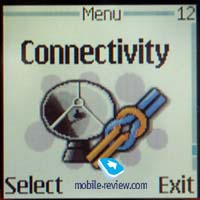
Services. WAP browser in version 1.2.1 is hidden here.
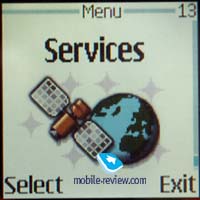
Impressions
The phone is comparable in connection quality to the other phones from Nokia.
In my opinion it is very good. The phone has a live and loud sound, sometimes
even too loud, so that you should reduce the volume. The phone also can work in
a handsfree mode, in this case the volume in the dynamic is not too high. It's
impossible to use it in noisy places.
The phone has a 4-tones polyphonic ring and supports up to 43 musical instruments.
So it is similar to the polyphony in Nokia 3510.The ringing volume is not sufficient,
especially outside. The sounds of the ring and the streets blend together. You
can listen to the phone ringing tones here.
The vibrating alert doesn't' improve the situation, it is also weak. It's difficult
to feel it in the jacket pocket. Unfortunately 7210 is inferior to other phones
from Nokia in this respect. You should listen to the phone carefully no to muss
the call.
There are no voice dialing, dictaphone and bluetooth here. A manufacturer decided
that a colour display is sufficient to appeal consumers.
The phone will appear in the shops at the end of September or in the beginning
of October, an expected retail price will be 500$. Of course, the colour diversifies
a live and it's more pleasing to have a colour screen. But I don't know is it
worth to pay such money for it, there are no more other interesting features here.
We can observe a deviation from the traditional models segmentation. At the beginning
of the article we said that Nokia 7210 was in an innovative class of models, but
now we can clue that the 7210 is a fashion class phone. So Nokia changes its strategy.
The example with Nokia 6610 is another evidence. This phone is similar to the
7210, only minors differ but nevertheless the 6610 is aimed to the classic segment.
When Nokia 7210 appears, the only its rival could be SonyEricsson T68i. If
to say about features T68i definitely wins the point but Nokia 7210 has a better
display and a polyphony. If to take into account that Nokia 7210 is a fashion
phone, it is anticipated that it will be sold good, usually users of this class
are practically not interested in additional features.
Nokia 7210, live pictures
Eldar Murtazin (eldar@mobile-review.com)
Translated by Maria Sennikova (maria@mobile-review.com)
Published — 11 September 2002
Have something to add?! Write us... eldar@mobile-review.com
|































